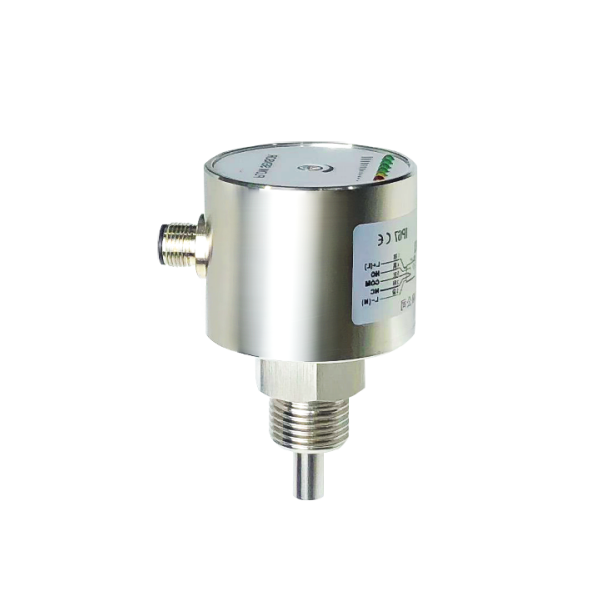
SI-600 thermal dispersion flow switch monitors the flow rate of fluid in the pipeline based on the thermal principle. Output PNP, NPN, relay, normally open + normally closed (SPDT) signal. Suitable for water, oil, air, and other media.
Thermal dispersion flow switch is widely used in petrochemical, electric power, metallurgy, steel mills, papermaking, food processing, water treatment, battery factories and other industries. It can also be used for flow interruption detection of pneumatic and hydraulic systems, circulating water, cutting fluid, lubricating oil, and idling protection of pumps.
Features
- The unique conical probe design can effectively prevent the entanglement of the winding objects in the medium.
- Fully waterproof shell design, unique waterproof adjustment knob, can be adjusted arbitrarily without removing the sealing screw, convenient and reliable.
- Suitable for a wide range of pipe diameters, arbitrarily adjust the set point, and optional anti-corrosion type.
- Pressure resistance up to 100Bar.
- Optional relay, analog output or analog switch integrated output.
- One model is used for multiple pipe diameter requirements.
- Use 6 LEDs to display the fluid flow rate status in real time.
- Monitoring functions: medium flow, reduce/increase flow rate; medium presence/absence; medium flow/stationary; monitor the flow rate of the fluid in the pipeline, flow interruption monitoring or prevent the pump from idling.
- Gas-liquid dual-purpose type.
SI-600 Thermal Dispersion Flow Switch Specifications
| Setting range: | 1…150cm/s (water), 3…300cm/s (oil), 20…2000cm/s (air) |
| Signal output: | PNP, NPN, relay, normally open + normally closed (SPDT) |
| Power supply: | 24V+20%VDC, 220VAC |
| Power on: | Maximum 400mA (PNP or NPN type) Maximum 4A (relay type) |
| No-load current: | Maximum 80mA |
| Flow indication: | LED row (6 pieces) |
| Setting method: | Potentiometer setting |
| Voltage range: | 100bar |
| Medium temperature change: | ≤4°C/s |
| Response time: | 1…13s, typical value 2s |
| Initialization time | About 8s |
| Electrical protection: | Reverse phase, short circuit, overload protection |
| Protection level: | IP67 |
| Medium temperature: | -20…80°C (customizable high temperature resistant type -40…150°C) |
| Ambient temperature: | -20…80°C |
| Storage temperature: | -20…100°C |
| Wiring method: | M12 connector/directly attached 2 meters wire optional |
| Material: | Probe–stainless steel (304/316 optional) Housing–POM (engineering plastic) |
| Repeat accuracy: | ±2% |
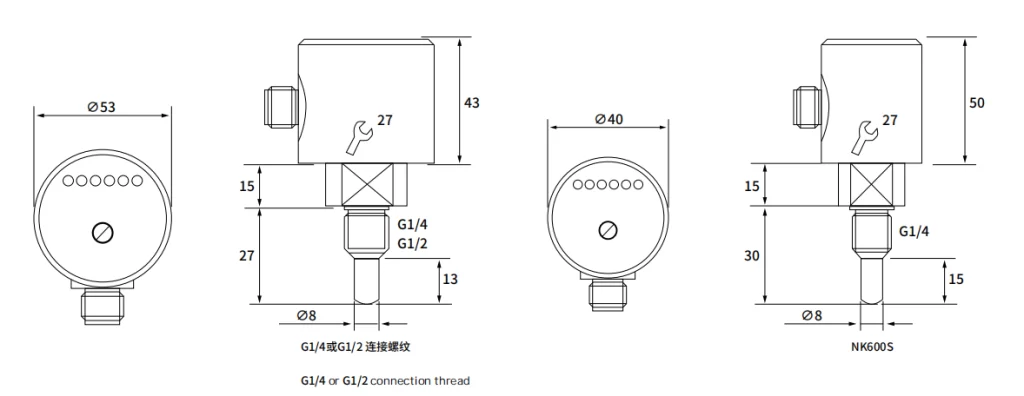
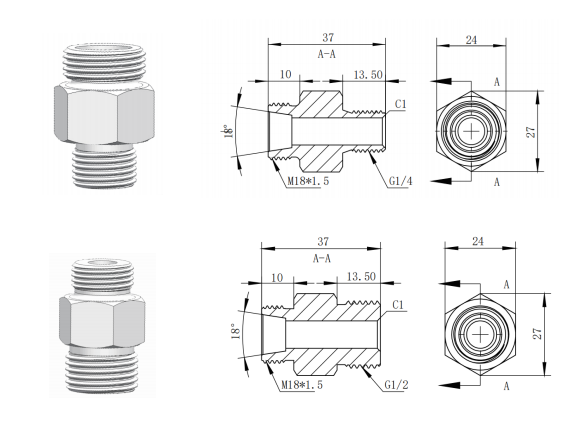
LED function and setting (switch type)
After the flow switch is installed, let the medium flow at the flow rate to be monitored.
Adjust the potentiometer so that the first green LED is just lit.
After that, when the flow rate is lower than the current value, the switch is released.
If you want to make the switch point smaller than the current flow rate, adjust the potentiometer to make the green LED brighter.
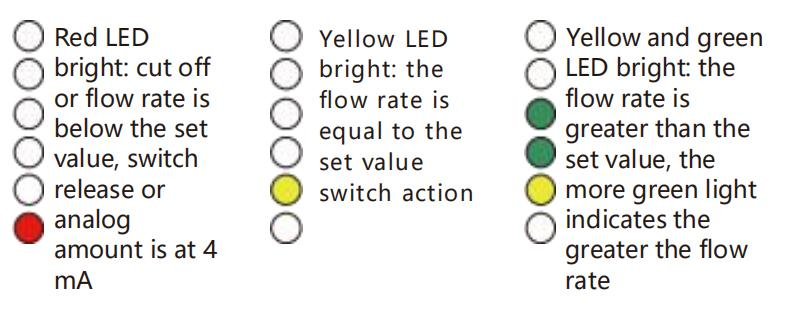
Wiring Diagram

Installation Notes

How does a thermal flow switch work?
Thermal flow switches are based on the principle of heat diffusion and detect flow changes by measuring the rate at which the fluid removes heat. Its core components usually include:
Heating element: usually a platinum resistor (RTD) or a thermistor
Temperature sensor: detects fluid temperature and heating element temperature
Control circuit: processes temperature signals and outputs switch signals
Mathematical expression of the working principle:
Q = h × A × (T_heated – T_fluid)
Where:
Q – heat conduction (W)
h – convection heat transfer coefficient (W/m²·K)
A – surface area (m²)
T_heated – heating element temperature (K)
T_fluid – fluid temperature (K)
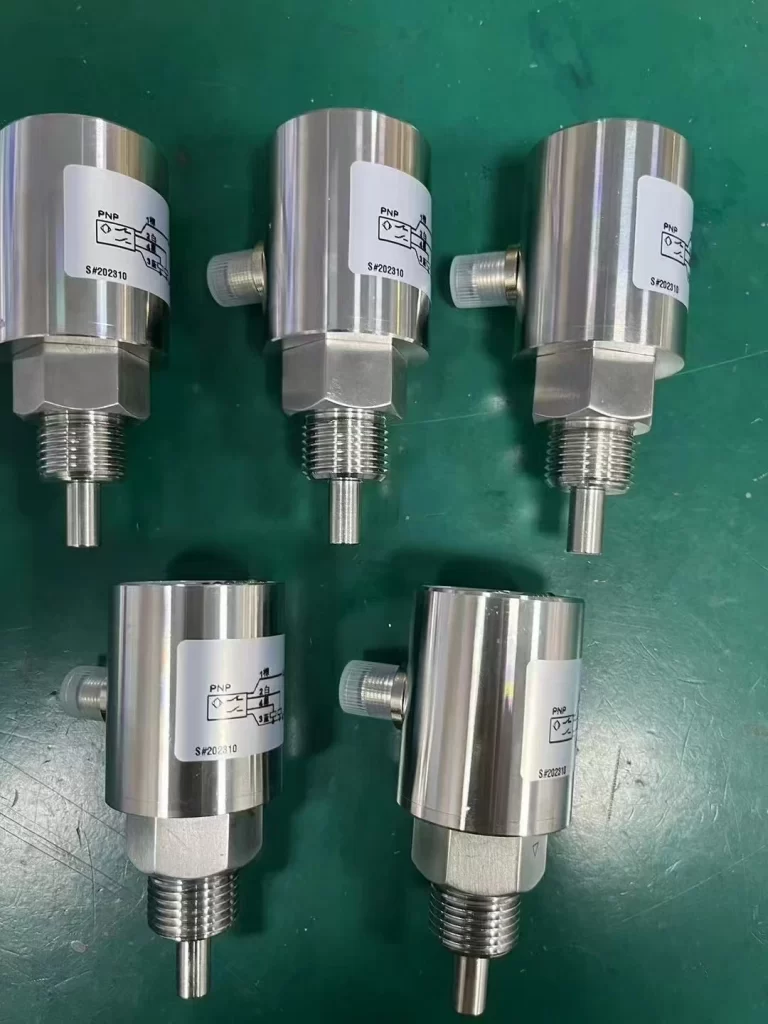
In the field of industrial automation, flow monitoring and control is an important part of achieving efficient and stable operation. As an advanced flow detection device, thermal conductivity flow switch plays a key role in many industrial scenarios with its high precision, high reliability and wide applicability.
Sino-Inst thermal dispersion flow switch is suitable for a variety of media and working conditions, including liquids, gases and other fluids. Its corrosion resistance and high temperature resistance enable it to operate stably for a long time in harsh industrial environments. In addition, the switch also supports a variety of output signal options, such as PNP, NPN, relays, etc., which is convenient for users to choose according to their actual needs.
If you need to purchase a flow switch, please feel free to contact our sales engineer!
-1.jpg)